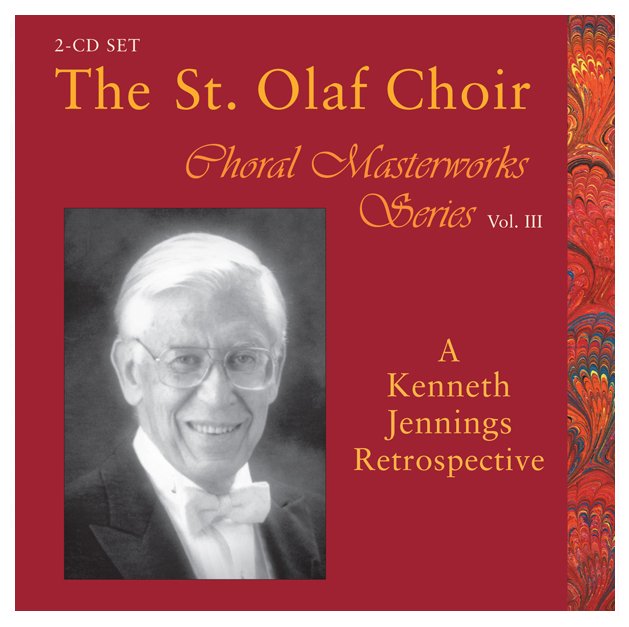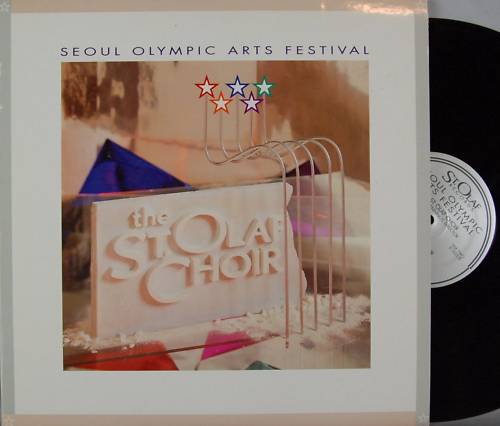 BD
BD| Kenneth Jennings (b. 1925) is Tosdal
Professor Emeritus of Music at St. Olaf College and Conductor Emeritus of
the St. Olaf Choir. A graduate of St. Olaf, he sang as a member of
the St. Olaf Choir as an undergraduate. He holds a master's degree
in composition from Oberlin Conservatory of Music, and a doctorate in choral
conducting from the University of Illinois. He was appointed to the faculty of St. Olaf College in 1953, and ascended to one of the world's most coveted choral podiums in 1968 as the third director of the internationally renowned St. Olaf Choir, succeeding founder F. Melius Christiansen and his son-successor, Olaf C. Christiansen. He retired from St. Olaf College in 1990, turning over the podium to his former student, Anton Armstrong. His Son, Dr. Mark Jennings, is the director of Choral Activities at Truman State University in Kirksville, Missouri. As director of the St. Olaf Choir Jennings became noted for guiding and maturing the group from one rooted substantially in its 1911 era founding to arguably one of the most highly respected choral ensembles of the world. Never forsaking the choir's Lutheran heritage, he successfully broadened the ensemble's repertoire to include works of noted composers of the post-World War II era. He led performances of the St. Olaf Choir in all major performing centers of the United states and many in Europe and Asia, including music festivals in Belgium, France, Germany, Holland, Italy, Norway and Korea. Under his leadership, the Choir also had a long and distinguished collaboration with the Minnesota Orchestra under the baton of Stanislaw Skrowaczewski and Neville Marriner. Since his retirement, he has served as a visiting professor and choral conductor at Gustavus Adolphus College in St. Peter, Minnesota and The University of Arizona, Tucson. Jennings served as the guest conductor at anniversary concerts in honor of F. Melius Christiansen. His continuing work as a composer includes commissions from the Dale Warland Singers, Cantus, Luther College, Gustavus Adolphus College, Kansas All-State Choir, Angelica Cantanti Choirbrook and the Choral Masterworks Series of historic recordings of the St. Olaf Choir. His numerous compositions and editions are widely published. |
 BD: What is the size of the choir?
BD: What is the size of the choir?| Jean Berger (1909-2002) was born Arthur
Schloßberg into a Jewish family in Hamm, Westphalia, and grew up in
Alsace-Lorraine. He studied musicology at the universities of Vienna and
Heidelberg, where he received his Ph.D. in 1931 with Heinrich Besseler as
his advisor. He also studied composition with Louis Aubert in Paris. While
working as the assistant conductor at an opera house in Mannheim, he was
forcibly removed from a rehearsal by Brown Shirts. After the Nazi Party seized
power in Germany in 1933, he moved in Paris, where he took the French name
Jean Berger, and toured widely as a pianist and accompanist. From 1939 to
1941, he was assistant conductor at the Municipal Theater in Rio de Janeiro
and on the faculty of the Brazilian Conservatory. He also toured widely throughout
South America. In 1941, he moved to the United States and served in the U.S.
Army starting in 1942. In 1943, he became a US citizen. He worked in the
Office of War Information producing foreign-language broadcasts and USO shows
until 1946. From 1946 to 1948, he worked as an arranger for CBS and NBC and
toured as a concert accompanist. In 1948 Berger moved into the academic world, taking a faculty position at Middlebury College in Middlebury, Vermont, which he held until 1959. From 1959 to 1961, he was on the faculty of the University of Illinois at Urbana-Champaign. From 1961 to 1966, he taught at the University of Colorado at Boulder and then the Colorado Women's College in Denver from 1968 to 1971. From 1970 on, he lectured widely throughout the world on various aspects of American music. -- From an article about Jean Berger
|
 KJ: We are going to Seoul, Korea later this summer, and
will sing about five concerts there during the Olympics.
KJ: We are going to Seoul, Korea later this summer, and
will sing about five concerts there during the Olympics. | Note: When interviews are posted on this site,
I attempt to contact my guest and/or their family or agents to let them know
of this further use of the material. Usually this is long after the
original meeting, and occasionally I get a response. In this instance,
I soon received a lovely e-mail reply, part of which is shown here . . .
. . . . Dear Bruce Duffie, What a great surprise to read this interview from 25 years ago!
As I remembered, it had not gone too badly. I never enjoyed being
interviewed as conductor of the choir, but I did enjoy talking to you on
this occasion. A very big thank you for resurrecting it from the depths
of your surprisingly long kept files of interviews of so many years ago.
Close now to 88 years old and retired for 23 years I have had great
pleasure reading what I thought about regarding music, conducting and the
choir some 25 years ago. Thank you so much for finding this old interview
and for your questions that facilitated my answers.
I believe that you were looking at St Olaf Choir recordings for
listening channels on Northwest Airlines (now swallowed up by Delta) perhaps
in light of the Choir's trip to Korea and the Summer Olympics. I can't
be sure that it was not prompted by the fact that the plane was being piloted
by Bob Matta whose daughter Michelle sang in the Choir. Nonetheless, when
we boarded the plane we found that Bob Matta was indeed the pilot and St
Olaf choir was on the classic listening channel! We sang 5 or 6 concerts
in Korea that summer including one in their very new concert hall.
Bruce, thank you for finding our interview and sending to me this
very special remembrance.
Best wishes,
Ken Jennings
|
This interview was recorded on the telephone on June 1, 1988.
Portions (along with recordings) were used as part of the in-flight
entertainment package aboard Northwest Airlines during July-August, 1988.
This transcript was posted on this website in 2013.
To see a full list (with links) of interviews which have been transcribed and posted on this website, click here.
Award - winning
broadcaster Bruce Duffie was with WNIB, Classical 97 in Chicago from
1975 until its final moment as a classical station in February of 2001.
His interviews have also appeared in various magazines and journals since
1980, and he now continues his broadcast series on WNUR-FM, as well
as on Contemporary Classical Internet Radio.
You are invited to visit his website for more information about
his work, including selected transcripts of other interviews, plus a full
list of his guests. He would also like to call your attention to
the photos and information about his grandfather,
who was a pioneer in the automotive field more than a century ago.
You may also send him E-Mail with
comments, questions and suggestions.